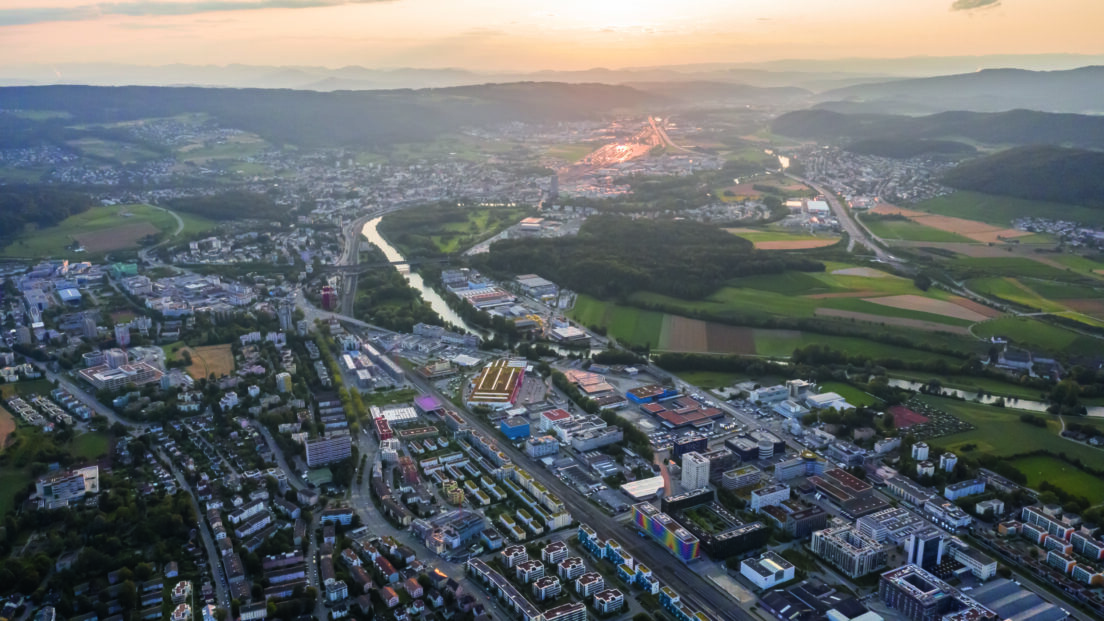From the Limmat Valley to the Limmat City: The enviable development of a region

The Limmat Valley from Baden to Zurich is a real powerhouse of dynamism, vitality and density of experiences. The formerly industrial region is developing into an attractive city on the Limmat, embedded in the hills and the Limmat region. The best development, new city quarters, cultural offers and active entrepreneurship are just a few of the location factors. The future Limmattalbahn will provide additional impetus. Sustainable and courageous visions have always been the driving force behind this development - not least in the cross-cantonal location promotion.
The Limmat Valley has changed like hardly any other region in Switzerland over the past few decades. Since the 1960s, the predominantly rural villages have been transformed into what is now a coherent urban landscape, embedded in a spacious landscape of forests, hills and recreational areas along the 36-kilometer-long Limmat.
From the Limmat Valley to the pulsating urban landscape
The transformation started with the economic boom of the post-war years. In Zurich's Limmat Valley, the population doubled between 1950 and 1960. The enormous boom was also reflected in large infrastructure buildings: the A1 motorway including the “Fressbalken” – the world's largest motorway bridge restaurant at the time – and the first shopping temple in Switzerland, the Shoppi Tivoli in Spreitenbach.
The intensification of de-industrialization from the 1980s onwards led to major upheavals in the Limmat Valley: On the one hand, jobs were created in the service sector, especially in the cities, which further fueled population growth. At the same time, the region suffered from this transformation. Traditional industrial companies had to restructure or even give up. The resulting industrial wastelands were initially unpleasant contaminated sites. It was not until the 1990s that their potential as mixed urban areas was recognized. In another wave of urbanization, they were developed into new city quarters. Examples of this are the conversion of the Wagi or Färbi area in Schlieren or the Limmatfeld in Dietikon: where the Rapid company used to produce agricultural machinery, a new district has been created on an area of 89,000 m2.
An important piece of Switzerland
Today the region has well over 200,000 inhabitants and 80,000 jobs, and the trend is rapidly increasing – also thanks to the preferred location at the gates of Zurich and the proximity to leading educational and research institutions. The present and future are shaped by the pioneering spirit of the industrial culture past, which is reviving in many traditional companies and in the enormously developing start-up scene. In addition, the emerging urban landscape and the rich industrial heritage leave a lot of space for design and development. At the same time, idyllic local recreation areas can be found in the immediate vicinity of pulsating urban spaces in the Limmat Valley. These include the Limmat or the green valley flanks, which can be reached within a very short time from anywhere in the Limmat Valley. All of this contributes significantly to the unique character and attractiveness of the region.
The future prospects are also extremely promising. On the one hand, the growth forecasts are intact. On the other hand, the region is once again experiencing a major upgrade thanks to the Limmattalbahn. The tram will connect Zurich, Schlieren, Urdorf, Dietikon, Spreitenbach and Killwangen with each other from December 2022. A continuation to Baden is being planned. The light rail network networks the region closely beyond the canton's borders and is the driving force behind numerous urban development projects.
Far-sighted development as a necessity
With this in mind, foresight is now more important than ever. Only with a regional understanding and coordinated planning does growth lead to a better quality of life. How can that be achieved? The growth should concentrate on the new urban focal points in the valley floor, where urban life should pulsate with high density and intensity in attractive public urban spaces. As a result, local recreation areas along the Limmat and especially on the valley flanks on the right bank of the Limmat can be protected. Instead of a random collection of settlements and communities, the Limmatstadt is to develop into an attractive urban area with supra-regional charisma embedded in the local recreation area.
Limmatstadt AG: A powerful location promotion for a strong region
Limmatstadt AG is consistently committed to networking the entire region and creating regional awareness. In particular, it wants to make their advantages and potentials better known both internally and beyond the region.
It is of central importance to join forces and strengthen the interaction between politics, business and society. This is the only way to ensure sustainable development and positioning. Until recently, there was no perspective on the region as a whole: Promotion of business locations ceased in the middle of the Limmat Valley, on the canton border. Only the creation of Limmatstadt AG in 2014 closed this gap.
The location promotion organization was created on a private initiative and is organized as a stock corporation. It is broadly anchored in the entire region with 160 corporate and public shareholders and is supported by 13 commissioned municipalities and the planning association of the Zurich planning group Limmattal. The network is growing and having an impact: It bundles strengths, promotes diversity, increases competitiveness and releases potential.
Limmatstadt AG is much more than a business network. It also provides a wide range of options for culture and society, always with the aim of creating awareness for the region. In addition, it addresses the urban development of the region and campaigns for sustainable development. ■
Use the effect and reach of our channels for the presence of your brand or service in the entire region. We are happy to help:
welcome@limmatstadt.ch
+41 44 434 24 05